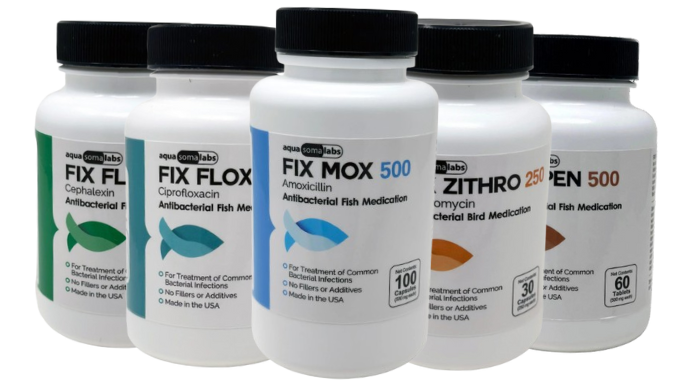Posted by Aquatic Veterinary Specialist on 21st Apr 2025
Popeye Disease in Aquarium Fish: Causes, Treatment & Prevention
Popeye Disease in Aquarium Fish
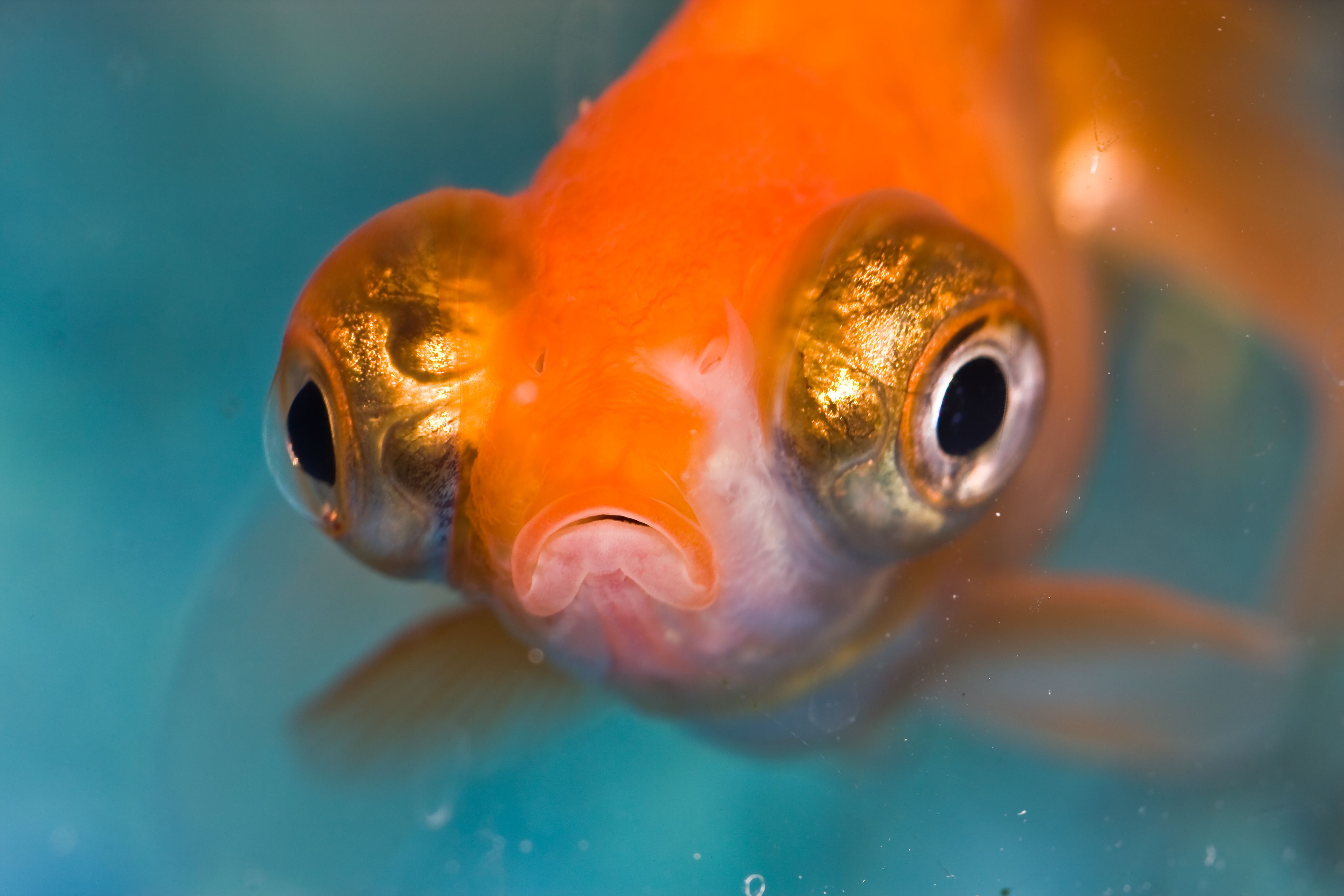
Popeye disease (exophthalmia) is a condition where one or both of a fish’s eyes swell and bulge abnormally from the socket. Affected eyes often appear cloudy or discolored, and if left untreated the fish can lose vision or even the entire eye. This issue matters to aquarium hobbyists because it signals an underlying problem in the tank and can be quite painful and dangerous for the fish. Understanding Popeye’s causes and treatment is crucial – with prompt care, most fish can recover fully, but without it, Popeye can lead to serious harm.
Causes of Popeye Disease in Aquarium Fish
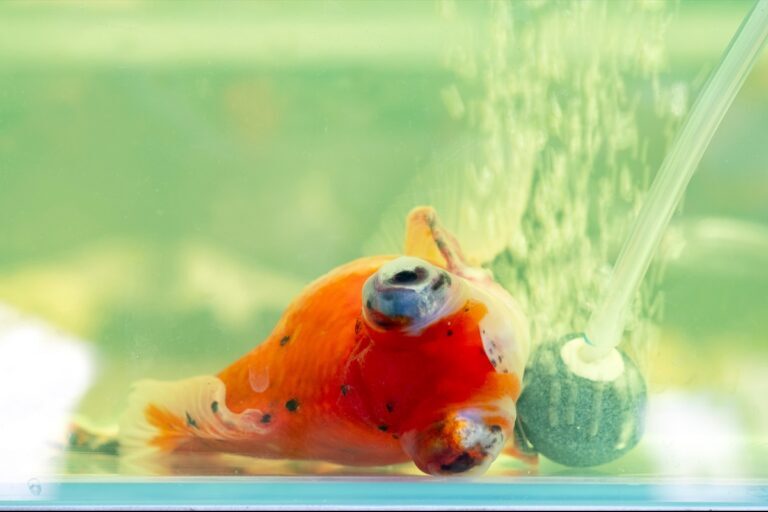
Popeye in fish is a symptom with multiple possible causes, and sometimes the exact cause may remain unknown. Knowing the common triggers can help you address the root problem:
-
Injury or Trauma: Physical damage is the #1 cause of fish Popeye. A fish might get spooked and bump into rocks or tank walls, or fight with tank mates, causing eye injury. If only one eye is affected (unilateral Popeye), an injury is likely to blame. You might even spot a scrape or bruise on the eye surface. The swelling is caused by the fish’s immune response to the injury.
-
Bacterial Infection: Many Popeye cases are caused by infections, especially when both eyes are affected (bilateral Popeye). Bacteria (and occasionally fungi or parasites) can infect the eye tissue or the area behind the eye, leading to pus or fluid buildup that pushes the eye outward. Often, an injury can become infected, or a systemic infection spreads to the eyes. If Popeye appears along with dropsy (swollen belly) or other systemic issues, internal infection or organ failure (like kidney problems) may be involved, which is more difficult to treat.
-
Poor Water Quality: Dirty or chemically imbalanced water is a very common cause of Popeye in aquarium fish. Chronic exposure to high ammonia or nitrite, high nitrate, or wildly fluctuating pH stresses fish and damages organs, leading to fluid retention behind the eye. In fact, long-term poor water conditions often result in bilateral Popeye cases. Overcrowded tanks and infrequent water changes make this more likely. Fish living in subpar water are also more prone to infections that cause Popeye.
-
Gas Bubble Disease: If you notice tiny bubbles clinging to the tank walls, decorations, or even under a fish’s skin, your water may be supersaturated with gas. Gas bubble disease occurs when microbubbles of air get into a fish’s bloodstream and tissues, often due to supersaturated water (for example, from a pump or fresh cold water containing excess dissolved gas). These bubbles can accumulate in the eye, physically causing it to bulge. While less common, gas bubble disease is another potential Popeye trigger, especially in tanks with microbubble issues or after large cold water changes.
-
Other Underlying Issues: In some cases, internal fluid imbalances or growths can cause an eye to protrude. For example, tumors behind the eye or severe internal organ failure (as seen in advanced dropsy) create pressure that pushes the eye outward. These situations are rare and often come with other clear signs of illness.
Key point: Often, unilateral Popeye points to injury, while bilateral Popeye points to infection or water quality problems, but this is not a hard rule. Always investigate all aspects – the fish’s recent behavior, water parameters, and any injuries – to determine the likely cause.
Symptoms and Stages of Popeye Disease
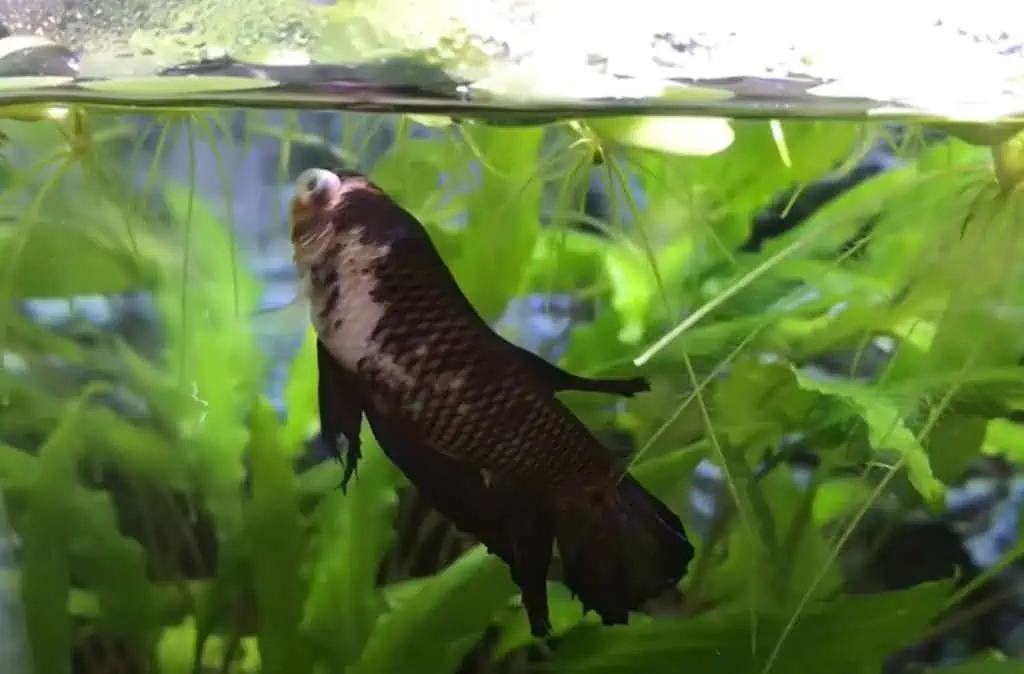
The hallmark symptom of Popeye disease is an eye (or eyes) visibly bulging outward. The extent can range from a slight protrusion (easy to miss at first) to a dramatic swelling where the eye juts out far from the head. Here are the common symptoms and how they progress:
-
Early Signs: A mild case may show a slight swelling of one or both eyes. In fish that do not normally have protruding eyes, even a small bulge is noticeable. The eye might still be clear at this stage, and the fish could appear otherwise normal. You might catch the issue early by comparing with other fish or the fish’s past appearance.
-
Moderate Symptoms: As pressure behind the eye increases, the eye socket stretches and the eyeball protrudes more. The affected eye often develops a cloudy or hazy appearance due to fluid or damage to the cornea. In some cases you may see discoloration or a red blood tint in the eye if blood vessels are damaged. The fish could start acting off – for example, it may eat less or hover in one spot – due to discomfort.
-
Severe Cases: In advanced Popeye, the eye can swell to an extreme size. The cornea (the clear surface of the eye) may rupture from the pressure, causing the eye to deflate or even leading to loss of the eye entirely. A ruptured eye often looks bloody, milky, or collapsed. At this stage, the fish is likely in pain and may be very inactive or stop eating. Both eyes bulging is particularly serious, as the fish may struggle to see food or predators at all. In worst cases, if underlying issues aren’t addressed, the fish could suffer permanent blindness or even death from the infection/stress.
-
Behavioral Changes: Along with eye symptoms, watch for general signs of illness. Fish with Popeye often exhibit lethargy or hiding, since they are stressed and possibly can’t see well. They might have a loss of appetite, only picking at food or ignoring it. Clamped fins (holding the fins tight against the body) and a swollen abdomen (if related to dropsy) are other clues something is wrong. Essentially, a fish with a bulging eye that is also acting sick definitely needs intervention.
Noticing Popeye early – when the eye just begins to swell – is important. Early-stage Popeye is often reversible. The eye’s cloudiness or bulging may improve with prompt treatment, and the fish can fully recover eyesight. In more advanced cases where the eye ruptures, the fish can survive and heal but will be blind in that eye thereafter. Many fish adapt fine to losing one eye (they can still live a normal life in your tank), but you want to prevent it from getting to that point if possible.
How to Treat Popeye in Aquarium Fish
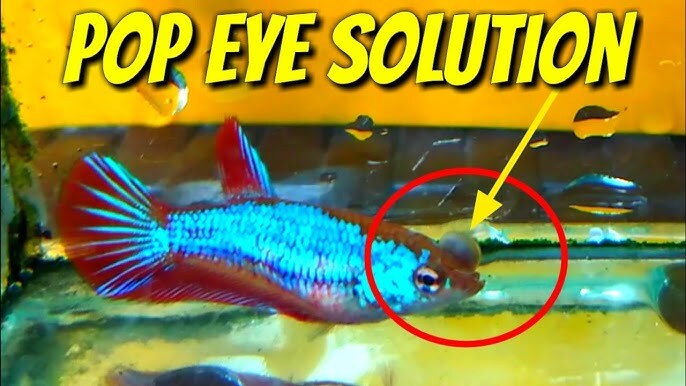
Treating Popeye involves a combination of improving the fish’s environment and direct care. It’s not as simple as just adding medicine – you need to fix any underlying cause while also helping the fish heal. Here is how to treat Popeye in aquarium fish step by step:
-
Check and Improve Water Quality: Start by testing your aquarium water immediately. Poor water conditions (detectable ammonia or nitrite, high nitrates, incorrect pH, etc.) can both cause Popeye and make it harder for fish to recover. Use an aquarium test kit to check ammonia, nitrite, nitrate, pH, and temperature. If any readings are out of the safe range, perform a series of partial water changes to slowly improve water quality. Clean up any waste, decaying food, or detritus in the tank as well. Stabilizing the water parameters relieves stress on all your fish and removes one major aggravating factor. In many cases, just fixing the water conditions can stop a mild case from worsening and help the fish’s immune system fight off infection.
-
Quarantine the Affected Fish: It’s best to move the fish with Popeye to a hospital tank if you have one. A simple quarantine tank with clean, conditioned water and aeration will allow you to treat the fish more effectively. Quarantine protects other fish in the community tank from a possible infection, and it prevents the injured fish from being picked on by tank mates. Make sure the quarantine tank’s water quality is excellent (zero ammonia/nitrite) and parameters are matched to the main tank to avoid additional stress. If multiple fish in your aquarium show Popeye or infection, you may need to treat the whole tank, but isolating the worst cases is still a good practice. While in quarantine, keep the tank dim and calm to reduce stress, and ensure the fish is still getting food (offering favorite foods or soaking pellets in garlic can entice a sick fish to eat).
-
Use Salt Baths or Epsom Salt: Aquarium salt or Epsom salt can be very helpful to reduce the swelling and aid healing. Epsom salt (magnesium sulfate) is often recommended for Popeye because it helps draw out excess fluid. You can add about 1 to 3 teaspoons of Epsom salt per 5 gallons of water in the quarantine tank. Dissolve the salt in a cup of tank water first, then pour it in. This treatment acts as a gentle anti-inflammatory for the fish, easing the pressure in the eye. If you don’t have Epsom salt, regular aquarium salt (sodium chloride) can also provide general support and help prevent infection. Salt baths should be used for several days and you can gradually dilute the salt out with water changes after the swelling goes down. Monitor the eye’s appearance – often swelling will gradually reduce and any cloudiness might start to clear as the salt and clean water do their work. Always follow recommended dosages; more salt is not always better.
-
Apply Appropriate Antibiotic Treatment: If a bacterial infection is suspected (which is likely if the eye is badly cloudy, if both eyes are affected, or if there was an injury), using an antibiotic can be the key to healing. In a quarantine tank, you can dose a broad-spectrum fish antibiotic to combat the infection. Common medications for Popeye include those used for other fish bacterial infections like fin rot – for example, products containing erythromycin, kanamycin, or sulfa drugs – which you add to the water. Make sure to remove any chemical filtration (like activated carbon) while treating, as it can absorb the medication. Follow the instructions on the antibiotic’s packaging carefully for dosage and duration. Usually, you’ll treat for at least 5–7 days, or as directed, to fully eliminate the bacteria. Never stop treatment early even if the eye looks better, or the infection might come back stronger. If the Popeye was due to an injury, antibiotics will help prevent a secondary infection while the eye heals. For severe infections or if over-the-counter fish meds aren’t helping, consider consulting a veterinarian for guidance – they may recommend stronger prescription antibiotics. (See the next section for effective fish antibiotics that can help in treatment.)
Throughout treatment, keep the water very clean and feed the fish high-quality, easily eaten food. Good nutrition and low stress will support the fish’s immune system in recovering. Popeye disease fish treatment can take some time – you might see improvement in a few days, but full healing (especially if the eye was badly damaged) could take a couple of weeks. Be patient and continue treatment as needed. If the fish’s eye ruptured, focus on preventing infection and helping the wound heal. The eye itself won’t regrow, but as long as the infection is cleared, the fish can recover and live with one eye.
Effective Fish Antibiotics for Popeye Disease
When treating Popeye that has a bacterial cause, choosing the right fish antibiotics can make a big difference in recovery. There are several effective medications available (often without a prescription) specifically made for fish. Here are some fish antibiotics that may support Popeye treatment (always use only one type of antibiotic at a time, and follow the product’s instructions):
-
Fish Amoxicillin: A broad-spectrum penicillin-type antibiotic. Fish Amoxicillin is commonly used for bacterial infections in fish, including those causing eye issues. It’s effective against a range of gram-positive and gram-negative bacteria and can help clear Popeye when used properly.
-
Fish Cephalexin: A cephalosporin antibiotic that targets many bacteria. This can be useful if the Popeye is due to gram-positive bacterial infection. It’s known for treating eye infections and body infections in aquarium fish.
-
Fish Penicillin: Another penicillin-class antibiotic. Fish Penicillin is effective for some common bacterial fish diseases. It can help in Popeye cases by inhibiting bacterial growth, especially with external infections in the eye area.
-
Fish Ciprofloxacin: A powerful broad-spectrum antibiotic from the fluoroquinolone class. Fish Ciprofloxacin can tackle stubborn bacteria, including gram-negative strains that might cause Popeye. It’s often used for serious infections in fish and can penetrate well into tissues like the eye.
-
Fish Metronidazole: An antibiotic effective against anaerobic bacteria and certain parasites. While Popeye is usually bacterial, Fish Metronidazole can be useful if there’s a mixed infection or if parasites (like Hexamita) are suspected to be involved along with the eye issue. It’s commonly used for internal infections and can help prevent secondary problems.
-
Fish Clindamycin: A lincosamide antibiotic that works well against certain gram-positive bacteria. It’s less commonly used in aquarium fish, but Fish Clindamycin may help with some Popeye cases, particularly if other antibiotics can’t be used. It’s known to treat skin and tissue infections in fish.
-
Fish Azithromycin: A macrolide antibiotic that’s effective against a variety of bacterial infections. Fish Azithromycin is sometimes used for fin rot and other infections; for Popeye, it can help by stopping bacteria from multiplying. It has the advantage of a relatively short treatment course in some cases.
-
Fish Doxycycline : A tetracycline-class antibiotic that is broad-spectrum. Fish Doxycycline can treat many external and internal infections in fish. It’s a good option for Popeye if the causative bacteria are susceptible to tetracyclines, and it’s often gentler on biological filters than some other antibiotics.
-
Fish Sulfamethoxazole: A sulfonamide antibiotic (usually used in combination with trimethoprim as SMZ-TMP). This medication can treat a wide range of bacterial fish diseases. In Popeye cases, Fish Sulfamethoxazole works by inhibiting bacterial growth and can be effective against gram-negative bacteria involved in eye infections.
-
Fish Fluconazole: Technically an antifungal (not an antibiotic for bacteria), Fish Fluconazole is useful if the Popeye is suspected to involve a fungal infection or if a fungal secondary infection is a risk. While most Popeye cases are bacterial, sometimes an eye injury can get a fungal infection. Fluconazole will help eliminate fungus and is safe for use in fish tanks when used correctly.
Using antibiotics: Select one antibiotic based on the suspected cause (when in doubt, a broad-spectrum like amoxicillin or ciprofloxacin is a common first choice). Follow the dosage instructions on the product – do not overdose, as it can harm your fish or the beneficial bacteria in your filter. Most fish antibiotics are added to the aquarium water; some can be mixed into food if the fish is still eating. Treat for the full recommended course even if the eye starts to look better, to ensure the infection is fully cleared. While treating with antibiotics, monitor ammonia and nitrite, as some medications can affect the bio-filter. Perform partial water changes between doses if instructed. If there’s no improvement after a full course of antibiotics, you may need to try a different medication or consult a vet for a proper diagnosis of the bacteria type.
Note: Antibiotics should be used responsibly. Ideally, if you have access to a vet, get guidance on which antibiotic is appropriate for your fish’s specific situation. Misusing antibiotics can lead to resistance or not actually treating the right problem. However, in many hobbyist situations, using these fish antibiotics in a timely manner can save your fish’s eye and life when Popeye is due to a bacterial infection.
Prevention of Popeye Disease
Preventing Popeye disease is all about maintaining a healthy, low-stress environment for your fish. Since Popeye has various causes, you need to cover all the bases of good aquarium care. Here are some effective prevention tips for aquarium hobbyists:
-
Maintain Excellent Water Quality: The best defense against Popeye (and many fish illnesses) is clean, stable water. Do regular partial water changes (e.g. 20-30% weekly or as needed) to keep nitrate levels low and refresh trace minerals. Use a good filtration system and test your water parameters frequently. Keep ammonia and nitrite at 0 ppm, nitrates as low as possible (certainly <40 ppm, ideally <20 ppm), and ensure the pH and temperature are appropriate for your fish. Consistent water quality means your fish’s immune system won’t be weakened by chronic stress.
-
Avoid Physical Trauma: Examine your tank setup and remove or cushion any sharp, rough decorations that a fish could injure its eye on. If you have excitable or skittish fish, provide plenty of space and hiding spots so they feel secure and aren’t dashing into the glass. Be careful when netting or handling fish – move slowly and gently to prevent accidents. Also, choose tank mates wisely: avoid aggressive combinations that lead to fights or nipping at eyes. If one fish is bullying others, separate it to prevent injury-induced Popeye.
-
Reduce Gas Supersaturation: Although rare in well-maintained aquariums, you should ensure your equipment isn’t causing microbubbles. Check filters, pumps, and airline connections for any tiny leaks that could inject air into the water. If you use very cold or tap water for water changes, let it sit and reach room temperature (or aerate it) before adding to the tank to release excess gases. This prevents gas bubble disease, which can cause Popeye-like symptoms. You’ll often see bubbles on surfaces or in fish eyes/skin if this is an issue, so keep an eye out and correct it (for example, fix leaking filter hoses or adjust aeration).
-
Feed a Healthy Diet: Good nutrition helps fish maintain a strong immune system. Feed a varied, high-quality diet appropriate for your species – this might include a mix of pellets or flakes plus frozen or live foods for vitamins. A well-fed fish is more resilient to infection and can heal from injuries faster. Also avoid overfeeding, which can foul the water; remove uneaten food promptly.
-
Quarantine New Additions: When you get new fish, consider quarantining them for a couple of weeks in a separate tank before introducing them to your main display. This practice can prevent introducing diseases or parasites that might cause Popeye or other illnesses in your established tank. During quarantine, you can observe the new fish for any signs of bulging eyes or infection and treat proactively if needed.
-
Monitor Your Fish Daily: Simply pay attention to your fish. Early detection is key for Popeye. If you notice even slight swelling of an eye or unusual behavior, take action by testing water and inspecting the fish closely. Catching problems early means you can correct causes (like water issues) before a full-blown Popeye develops. Routine observation will also alert you to any aggression or environmental issues that could injure your fish. Think of it as a daily health check for your aquarium.
By following these preventive measures, you greatly reduce the chances of Popeye disease appearing in your aquarium. A clean tank, peaceful environment, and healthy fish go a long way. However, if Popeye does occur, you’ll be prepared to tackle it promptly. Most importantly, addressing the root cause – whether it’s dirty water, an aggressive tank mate, or an infection – will ensure that once your fish’s eye heals, the problem is unlikely to return. With good care, Popeye is usually a manageable and non-recurring issue, and your fish can continue to thrive.
Ultimately, staying informed and proactive is the best strategy. Popeye disease in fish can sound scary, but with the knowledge of its causes, symptoms, and treatments, you can handle it like a pro. Happy fish keeping, and may your aquatic friends always have clear, bright eyes ahead!
Sources:
-
The Spruce Pets – Popeye Disease in Aquarium Fish: Causes, Treatment, and Preventionthesprucepets.comthesprucepets.comthesprucepets.comthesprucepets.comthesprucepets.comthesprucepets.comthesprucepets.com
-
Aquarium Source – Popeye Disease in Fish: Causes, Treatment & Preventionaquariumsource.comaquariumsource.comaquariumsource.com
-
CA Fish Vet (Dr. Jessie Sanders) – Fish Popeye: Common Causes, Best Treatments & Prevention cafishvet.com

